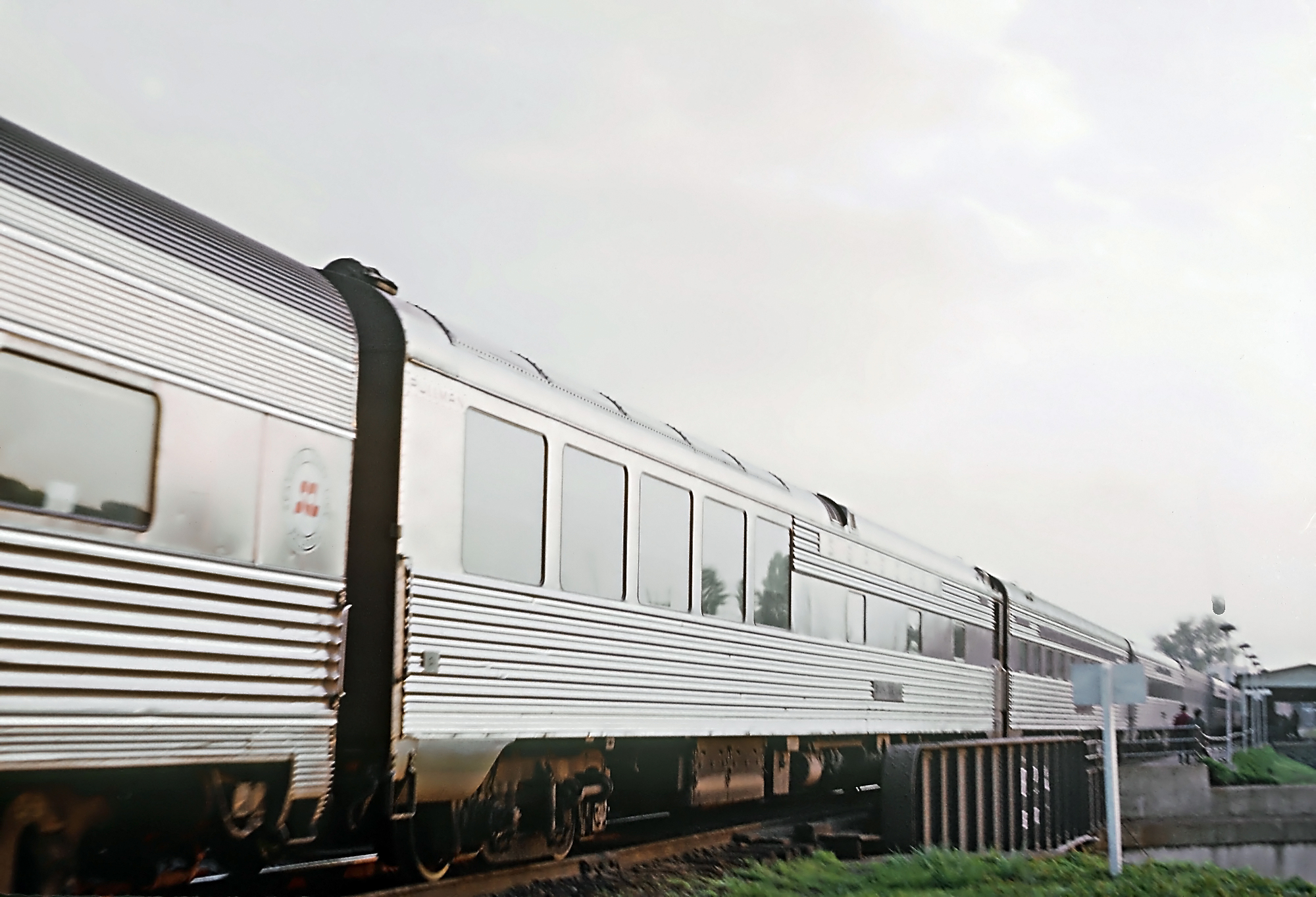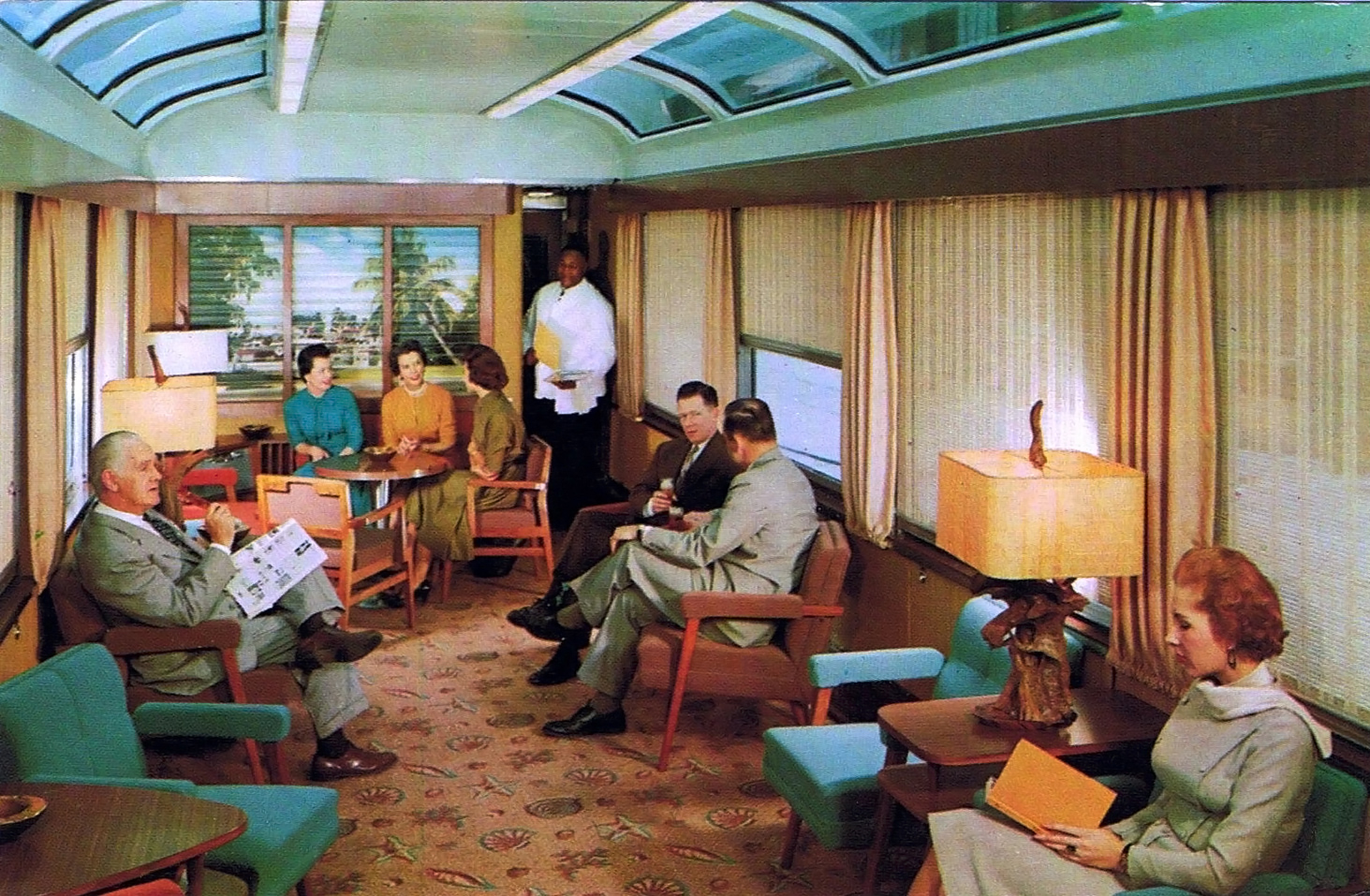"Sun Lounge" (Railcar): History, Photos, Design
Published: February 8, 2025
By: Adam Burns
The Seaboard Air Line's 'Sun Lounge' was an innovative concept which blended the dome car's solarium concept into a traditional car.
The cars comprised a trio of sleeper-lounges constructed by Pullman-Standard in 1956. They featured a glazed roof section designed to emulate the allure of a dome car, yet with a lower profile to accommodate the height restrictions posed by tunnels along the East Coast, where standard domes could not operate.
The Seaboard deployed all three cars within its premier service, the Silver Meteor, navigating the route between New York City (via the PRR between New York and Washington) and Miami. Today, two out of the three Sun Lounges remain extant under private ownership.
 A Seaboard Coast Line 'Sun Lounge' is on RF&P's Train #57, the "Silver Meteor," arriving at Alexandria Union Station (Virginia) on Aptril 29, 1969. Roger Puta photo.
A Seaboard Coast Line 'Sun Lounge' is on RF&P's Train #57, the "Silver Meteor," arriving at Alexandria Union Station (Virginia) on Aptril 29, 1969. Roger Puta photo.Development
The Seaboard Air Line operated from 1900 to 1967, serving a network of 4,100 route miles that spanned from Virginia to Florida. Renowned for its passenger trains such as the Silver Meteor, Silver Star, and Silver Comet, SAL sought to enhance the travel experience by integrating unique offerings that would distinguish it from competitors.
In fact, the railroad was the first southern system to inaugurate a streamliner when the Silver Meteor entered service on February 2, 1939. To further enhance the train's accommodations SAL management wanted to enter the dome car concept, which led to the creation of the Sun Lounge.
The car was designed specifically to provide the solarium appeal and sightseeing opportunities offered by a standard dome car while providing the clearance restrictions necessary for tunnels located in Baltimore and New York City when operating over the PRR.
Essentially, the Sun Lounge was simply a standard-height, lightweight streamlined car with large windows spanning roughly half the carbody, including along the roof.
Design
The idea of a "sun lounge" or "sun parlor" in rail travel was not novel. As early as 1911, the Illinois Central's Panama Limited featured a "sun-parlor" observation car adorned with wrap-around windows and a refined mahogany interior.
Similarly, in 1931, the Seaboard Air Line incorporated a "lounge sun-parlor car" into the Southern States Special, one of its routes running from New York to Florida.
The raiload, in conjunction with Pullman, completed three Sun Lounge cars in 1956 named Miami Beach, Palm Beach, and Hollywood Beach (numbered 18 through 20). The sleeper-lounges embodied the luxurious experience of a dome car within a single-level design and partitioned into two segments.
One section housed five double bedrooms, while the opposite end featured a lounge area designated for the use of sleeping car passengers. A quaint bar, strategically placed between these two areas, catered to the refreshment needs of the passengers.
The lounge was distinguished by expansive picture windows and a glass-paneled roof, which emulated the panoramic allure of a dome car. The interior of the lounge was adorned with Floridian influences, including light fixtures crafted from driftwood. In contemporaneous marketing campaigns, the Seaboard vividly highlighted the Sun Lounge's unparalleled design, proclaiming it as "unlike anything on the rails at present."
The cars' interiors were a testament to the opulent approach that SAL embraced to attract passengers. They were equipped with plush seating, elegant décor, and amenities that catered to luxury travelers.
The functionality of the Sun Lounge railcars was further enhanced by a sophisticated ventilation system, which ensured that the comfort of passengers was maintained regardless of external temperatures.
During the summer months, when heat retention might otherwise have been an issue, this feature ensured a cooling airflow, mitigating the effects of the sunlit exposure.
Technologically, the design of the cars required complex engineering to ensure the structural integrity and stability of such large glass panels amidst the vibrations and rigors of rail travel. The strength and resilience of the materials used were indicative of the era’s advancements in railcar construction, emphasizing durability without compromising on aesthetic appeal.
Beyond technical and luxury aspects, these railcars symbolized a cultural moment in American travel, where railway companies strove to provide not merely transportation but an experience all its own. The vision behind the Sun Lounge was to imbue the journey itself with a sense of discovery and pleasure, transforming the practice of rail travel into a scenic engagement with the environment.
Later Years
Following the 1967 merger of the Seaboard Air Line and Atlantic Coast Line, forming Seaboard Coast Line, the Sun Lounge cars were renamed to align with SCL's standardized naming practice:
- Hollywood Beach was renamed Sun Ray
- Miami Beach became Sun View
- Palm Beach was rechristened as Sun Beam
The cars were numbered 6500 to 6502 and reassigned to Seaboard's existing 5 double bedroom-buffet-lounge cars.
In 1971, Amtrak assumed control of the Sun Lounges, retaining the SCL appellations while once again changing their numbers to 3200–3202. The Sun Lounge cars continued to serve the Silver Meteor but were shifted to the Florida Special during the 1971-1972 winter season.
The Sun View car was retired in 1977, with Sun Beam and Sun Ray subsequently withdrawn from service in 1981. Notably, none of these cars were upgraded to head-end power under Amtrak's Heritage Fleet program. The Sun Beam (formerly Palm Beach) was dismantled in the 1980s, whereas the remaining two cars, Sun Ray and Sun View, have entered private ownership.
Specifications
| In Service | 1956-1981 |
| Manufacturer | Pullman-Standard |
| Entered Service | 1956 |
| Scrapped | ~1980 (Sun Beam/Palm Beach) |
| Number Built | 3 |
| Fleet Numbers | 18–20 (SAL), 6500–6502 (SCL), 3230–3232 (Amtrak) |
| Capacity | 5 double bedrooms |
| Car Length | 85 feet |
| Width | 10 feet 6 inches |
| Height | 13 feet 6 inches |
| Wheel Diameter | 36 inches |
| Weight | 135,100–135,700 pounds |
Legacy
In retrospect, the Sun Lounges were more than just a mode of transit; they were an embodiment of a bygone era of railroading that balanced the art of travel with the expertise of engineering.
They illustrate a chapter in American history where the promise of the journey was as significant as the destination itself—an ethos that continues to resonate with those who appreciate the golden age of rail travel.
Through their panoramic views and inviting allure, the cars provided a spectacular window to the world, and in doing so, they left a lasting impression on rail transportation in the United States.
Recent Articles
-
Kentucky - Murder Mystery - Dinner Train Rides
Dec 16, 25 12:49 PM
In the realm of unique travel experiences, Kentucky offers an enchanting twist that entices both locals and tourists alike: murder mystery dinner train rides. -
Utah - Murder Mystery - Dinner Train Rides
Dec 16, 25 12:44 PM
This article highlights the murder mystery dinner trains currently avaliable in the state of Utah! -
Alabama - Murder Mystery - Dinner Train Rides
Dec 16, 25 11:36 AM
There is currently one location in the state offering a murder mystery dinner experience, the Wales West Light Railway!




